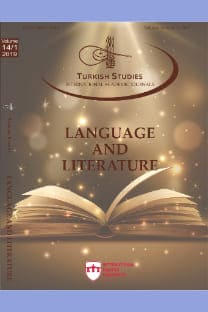Çeviri Hizmeti Sağlama Alt-Edinci ve Meslek Alt-Edincinin Çevirmen Ulusal Meslek Standardı’ndaki Yeri: Çeviri Eğitiminde Neden Bu Alt-Edinçlere Yer Verilmelidir?
The Relevance of Translation Service Provision Sub-Competence and Occupational SubCompetence in the National Occupational Standard for Translator/Interpreter: Why Should These Sub-Competencies Be Integrated into Translation Education?
___
- Akalın, R. (2016). Akademik çeviri eğitiminde açısından çeviri edinci kavramı ve içerimleri. Diyalog, Interkulturelle Zeitschrift Für Germanistik, 4(2), 56-65. https://dergipark.org.tr/tr/pub/diyalog/issue/27718/292414
- Akdağ, A. I. (2015). Mütercim tercümanlık öğrencilerinde çeviri edincinin ölçülmesi ve değerlendirilmesi [Yayınlanmamış doktora tezi]. İstanbul Üniversitesi, Sosyal Bilimler Enstitüsü, Çeviribilim Anabilim Dalı.
- Albir, A. H. (2015). The acquisition of translation competence, competencies, tasks, and assesstment in translator training. META, 60(2), 256-278. https://doi.org/10.7202/1032857aradresse copiéeune erreur s'est produite
- Bowen, G. (2009) Document anaysis as a qualitative research method. Qualitative Research Journal 9(2), 27-40. https://doi.org/10.3316/QRJ0902027
- Directorate-General for Translation. (2011). Conclusions of the symposium on the translator profile: What skills for a changing market? Brussels, 29.9.2011. Brussels: European Commission
- EMT Expert Group (2009). Competencies for professional translators, experts in multilingual and multimedia communication. http://ec.europa.eu/dgs/translation/programmes/emt/key_documents/emt_competen ces_translators_en.pdf
- EMT Expert Group. (2017). Competence framework 2017. https://ec.europa.eu/info/sites/info/files/emt_competence_fwk_2017_en_web.pdf
- Eser, O. (2013). Çeviri eğitiminde edinç kavramının değerlendirilmesi [Yayınlanmamış doktora tezi]. İstanbul Üniversitesi, Sosyal Bilimler Enstitüsü, Çeviribilim Anabilim Dalı.
- Eser, O. (2014). Çeviri eğitiminde edinç kavramının değerlendirilmesi- Türkiye örneği. Uluslararası Sosyal Araştırmalar Dergisi, 7(33), 135-156. https://www.sosyalarastirmalar.com/cilt7/sayi33_pdf/1dil_edebiyat/eser_oktay.pdf
- Garces, C.V. & Toudic, D. (2015). Technological innovation and translation. Training translators in the EU for the 21st century. VERBEIA: Journal of English and Spanish Studies 0, 183- 202. https://journals.ucjc.edu/VREF/issue/view/188
- Göpferich, S. (2009). Towards a model of translation competence and its acquisition: the longitudinal study Transcomp, S. Göpferich, A. L. Jakobsen & I.M. Mees içinde (Ed.)Behind the mind: methods, models and results in translation process research (ss. 11-37). Copenhagen Studies in Language (37). Samfundslitteratur Press.
- Kiraly, D. C. (2013). Towards a view of translator competence as an emergent phenomenon: Thinking outside the box(es) in translator education, D. Kiraly, S. Hansen-Schirra, & K. Maksymski içinde (Ed.), New prospects and perspectives for educating language mediators, (ss. 197–224). Narr Press.
- Mesleki Yeterlilik Kurumu. (2013a). Çevirmen ulusal meslek standardı, seviye 6 (12UMS0274-6). https://portal.myk.gov.tr/index.php?option=com_meslek_std_taslak&view=taslak_listesi_y eni&msd=2&Itemid=432
- Mesleki Yeterlilik Kurumu. (2013b). National occupational standard translator /interpreter, level 6 (12UMS0274-6). https://portal.myk.gov.tr/index.php?option=com_meslek_std_taslak&view=taslak_listesi_y eni&msd=2&Itemid=432
- Mesleki Yeterlilik Kurumu. (t.y.). Ulusal meslek standartları. https://www.myk.gov.tr/index.php/tr/ulusal-meslek-standard-ana
- Mesleki Yeterlilik Kurumu. (t.y.). National occupational Standard. https://www.myk.gov.tr/index.php/en/national-occupational-standards
- PACTE. (2003). Building a translation competence model, F. Alves içinde (Ed.), Triangulating translation: perspectives in process oriented research (ss. 43-66). Johns Benjamins Publishing.
- PACTE. (2005). Investigating translation competence: conceptual and methodological issues. META 50 (2), 609-619. https://doi.org/10.7202/011004ar
- PACTE. (2011). Results of the validation of the PACTE translation competence model: translation problems and translation competence. C. Alvstad, A. Hild& E. Tiselius içinde (Ed.), Methods and Strategies of Process Research: Integrative Approaches in Translation Studies (ss. 317-343). Johns Benjamins Publishing.
- Schaffner, C. & Adab, B. (2000). Developing translation competence. John Benjamins Publishing. T.C. Çalışma ve Sosyal Güvenlik Bakanlığı, Mesleki Yeterlilik Kurumu. https://www.myk.gov.tr/images/articles/TYC/seviye_tanimlayicilari.pdf
- Yazıcı, M. (2007). Yazılı çeviri edinci. Multilingual.
- Yıldız, M. (2020). A case of situated learning and its implications for the development of translator competence. Rumelide Dil ve Edebiyat Araştırmaları Dergisi 8, 1000-1015. doi: 10.29000/rumelide.827642
- Yılmaz-Gümüş, V. (2018). Solidity and professionalization of translation: Turkey as a case in point. Hermes-Journal of Language and Communication in Business 58, 44-60. https://tidsskrift.dk/her/article/view/111661
- ISSN: 2667-5641
- Yayın Aralığı: 4
- Başlangıç: 2006
- Yayıncı: ASOS Eğitim Bilişim Danışmanlık Otomasyon Yayıncılık Reklam Sanayi ve Ticaret LTD ŞTİ
Salah Birsel’in Şiirlerinde Dil Sapmaları
Selim İleri'de Reşat Nuri'nin İzini Sürmek
Zekâya Bağlı Bir Sanat Hüsn-i Tahallüs ve Hayâlî Bey’in Gazellerinde Kullanımı
Âşık Paşa’nın Gazellerine Dair Bazı Düşünceler ve Bilinmeyen Dört Şiiri
Revelation and Unfolding of a Dystopian Novel: Never Let Me Go by Kazuo Ishiguro*
An Ecofeminist Reading of Charlotte Perkins Gilman’s “The Yellow Wallpaper” (1892)
Turan Özgür GÜNGÖR, Nazmiye ZEYBEK
Reşat Nuri Güntekin'in Yeşil Gece Adlı Romanında Kavram Alanı Üzerine Bir Deneme
